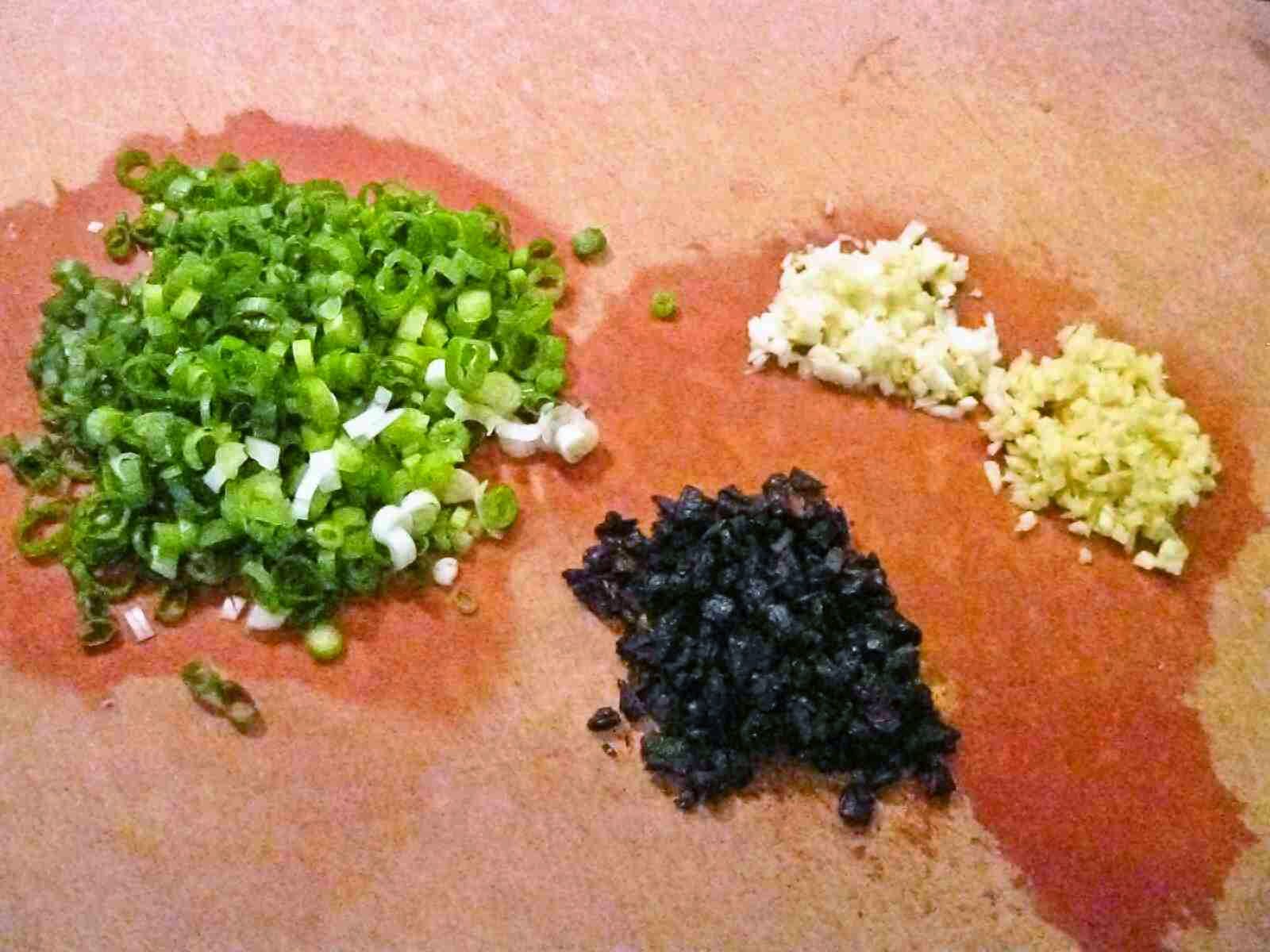Very tasty. One of my favorite Chinese dishes from our kitchen, now made to be sodium savvy by tweaking seasoning in the original recipe -- replacing sake with Shaoxing wine, black bean paste with black beans themselves, partially replacing soy sauce with shoyukoji as well as tobanjan with red chili pepper, and adding kurozu brown rice vinegar. While this features bay shrimp, it is also good with ground or finely chopped pork or a combination of pork and beef.
1/4 of recipe:
174 calories; 12.8 g protein; 7.3 g fat; 12.6 g carbohydrate; 11.6 g net carbs; 351 mg sodium (when using 50% reduced-sodium soy sauce and shoyukoji made of reduced-sodium soy sauce); 44 mg cholesterol; 2.0 g fiber
<Ingredients>
(Serves 4)
1 large kinugoshi soft tofu (460 g in photo)
Handful bay shrimp (80 g in photo)
2 tsp hua jiao Sichuan peppercorns
1 medium or 2 small green onions
1 medium or 2 small cloves garlic
1 small knob ginger
2 taka no tsume red chili peppers (slices in photo)
1 tbsp douchi fermented black beans
For seasoning
50 cc chicken stock
1/2 tbsp oyster sauce
1 tbsp shoyukoji soy sauce rice malt
2 tsp soy sauce
1 tbsp Shaoxing wine
1 tsp kurozu brown rice vinegar
1/2 tsp tobanjan
1 tsp sugar
1 tbsp canola oil (to cook ingredients; not in photo)
1/2 tsp sesame oil (to add aroma at the end; not in photo)
1-2 tsp katakuriko potato starch, mixed with equal amount or slightly more cold water (not in photo)
<Directions>
1.
Place tofu on zaru flat strainer to eliminate excess water.
2.
Mix all ingredients for seasoning.
Set aside.
Mix katakuriko potato starch and water.
Set aside.
3.
Finely chop green onion, garlic, ginger and douchi.
4.
In a pan, heat oil, and saute hua jiao for a few minutes on medium low heat until fragrant.
Discard hua jiao.
5.
Put garlic, ginger and green onion, and fry until fragrant.
Add douchi, and mix.
Add red chili pepper, and mix.
When douchi become fragrant, add shrimp, and stir.
6.
Meanwhile, cut tofu into 2cm cubes.
7.
Add tofu to pan (after getting rid of water pooled on cutting board, if any).
Gently turn with spatula.
If ingredients seem watery, raise heat to eliminate water.
8.
Add seasoning mixture, and bring to boil.
Once boiling, reduce heat to medium low or low, and simmer for 5-10 minutes while occasionally turning gently for even flavoring.
9.
Mix katakuriko and water again, and add to pot to thicken broth.
Add sesame oil, and gently turn.
Ready to serve.
<Notes>
1/4 of recipe:
174 calories; 12.8 g protein; 7.3 g fat; 12.6 g carbohydrate; 11.6 g net carbs; 351 mg sodium (when using 50% reduced-sodium soy sauce and shoyukoji made of reduced-sodium soy sauce); 44 mg cholesterol; 2.0 g fiber
<Ingredients>
1 large kinugoshi soft tofu (460 g in photo)
Handful bay shrimp (80 g in photo)
2 tsp hua jiao Sichuan peppercorns
1 medium or 2 small green onions
1 medium or 2 small cloves garlic
1 small knob ginger
2 taka no tsume red chili peppers (slices in photo)
1 tbsp douchi fermented black beans
For seasoning
50 cc chicken stock
1/2 tbsp oyster sauce
1 tbsp shoyukoji soy sauce rice malt
2 tsp soy sauce
1 tbsp Shaoxing wine
1 tsp kurozu brown rice vinegar
1/2 tsp tobanjan
1 tsp sugar
1 tbsp canola oil (to cook ingredients; not in photo)
1/2 tsp sesame oil (to add aroma at the end; not in photo)
1-2 tsp katakuriko potato starch, mixed with equal amount or slightly more cold water (not in photo)
<Directions>
1.
Place tofu on zaru flat strainer to eliminate excess water.
2.
Mix all ingredients for seasoning.
Set aside.
Mix katakuriko potato starch and water.
Set aside.
3.
Finely chop green onion, garlic, ginger and douchi.
4.
In a pan, heat oil, and saute hua jiao for a few minutes on medium low heat until fragrant.
Discard hua jiao.
5.
Put garlic, ginger and green onion, and fry until fragrant.
Add red chili pepper, and mix.
6.
Meanwhile, cut tofu into 2cm cubes.
7.
Add tofu to pan (after getting rid of water pooled on cutting board, if any).
Gently turn with spatula.
If ingredients seem watery, raise heat to eliminate water.
8.
Add seasoning mixture, and bring to boil.
Once boiling, reduce heat to medium low or low, and simmer for 5-10 minutes while occasionally turning gently for even flavoring.
9.
Mix katakuriko and water again, and add to pot to thicken broth.
Ready to serve.
<Notes>
- This tastes great the next day, too.
- Make sure to mix katakuriko and water well before adding it to the pot, because katakuriko tends to sink to the bottom. How much katakuriko + water mixture to add depends on how much liquid there is in the pot. For the above dish, I added about 1 tsp of katakuriko (+ 1 tsp water).
- Momen firm tofu is usually the choice for mabodofu. Kinugoshi soft tofu makes it tender and works well with bay shrimp.
- If you do not like vinegar in general, 1 tsp of kurozu brown rice vinegar might make the vinegar taste noticeable in the final dish. To prevent this, you can reduce the amount to 2/3 tsp, or first microwave kurozu briefly (5 seconds or so) before mixing it with other seasoning ingredients.
- Chinese brown rice vinegar (hei cu) has a more distinctive taste and aroma than Japanese kurozu. However, hei cu usually contains sodium, so I stay with Japanese kurozu (sodium free).
- I use homemade chicken stock containing far less sodium than store-bought stock.
- This recipe is quite mild. To make it spicier, add more red chili pepper, Vietnamese chili paste or chili garlic sauce. Tobanjan, of course, works too, but its sodium content is more than twice as high as that of chili paste or garlic sauce.




















No comments:
Post a Comment